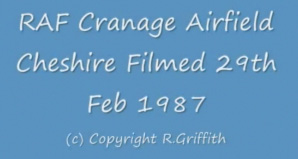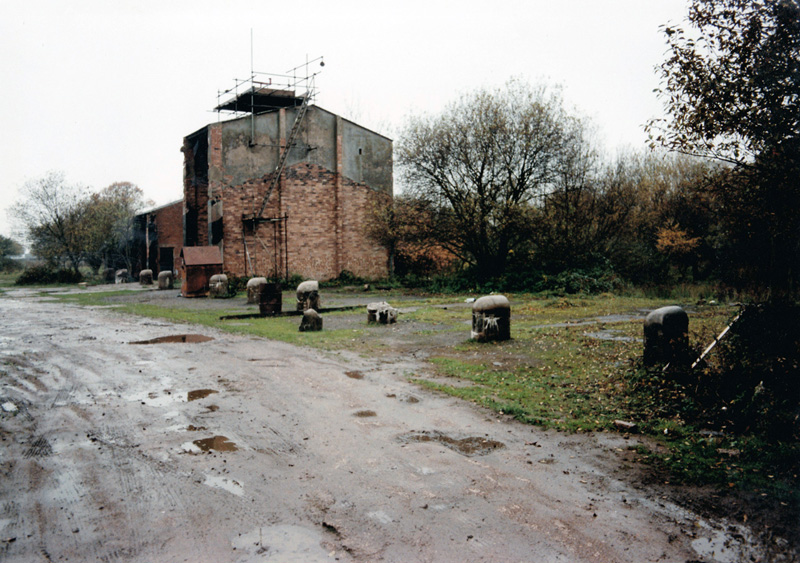
The images and video on this page are copyright of Roland Griffiths, please do not distribute these to other websites without permission.
 A four minute video by Roland Griffiths.
A four minute video by Roland Griffiths.
The video is 640 x 480 - 47.2Mb, best viewed on a computer or tablet, though it can be viewed on a smart-phone too.











Cranage M.T. Sheds - 1987
Looking south from the top of the north side of the Motor Transport compound. At the time of these photographs, the airfield was being used as a motorcycle scramble course. The Scaffolding was put up as a viewing platform for this purpose.
Other than the odd shelter, these were the last of the buildings on the main part of the camp.
Cranage M.T. Sheds - 1987
Looking south from the top of the north side of the Motor Transport compound. At the time of these photographs, the airfield was being used as a motorcycle scramble course. The Scaffolding was put up as a viewing platform for this purpose.
Other than the odd shelter, these were the last of the buildings on the main part of the camp.
This photograph is a composition of the first two.
From the top of the M.T. Sheds - 1987
As can be seen in the graphic below, this photo is taken from the top of building No.62, the uppermost light green shape.
The view is looking west towards the main gates.
The M.T. Sheds - 1987
Looking west at the north side of the M.T. Sheds.
The M.T. Sheds - 1987
Looking north at the north side of the M.T. Sheds.
Demolition - 1987
It is believed that some of the demolition work was carried out by Blaster Bates (Derek Macintosh Bates). As an ex-R.A.F.Handley Page Halifax pilot, and later a bomb disposal expert, Bates, a local man, originally from Crewe was using newly developed explosives from I.C.I.
It is testament to the local builders, who having ‘modified’ the shelters etc. from the Standard construction drawings, that while the building did indeed collapse, they certainly didn’t ‘explode’ as it was thought they would
Demolition - 1987
It is believed that some of the demolition work was carried out by Blaster Bates (Derek Macintosh Bates). As an ex-R.A.F.Handley Page Halifax pilot, and later a bomb disposal expert, Bates, a local man, originally from Crewe was using newly developed explosives from I.C.I.
It is testament to the local builders, who having ‘modified’ the shelters etc. from the Standard construction drawings, that while the building did indeed collapse, they certainly didn’t ‘explode’ as it was thought they would
Hudson AE618 Crash Site
Roland [shown on left in the photograph], along with his friends did some research into the crash site of Hudson AE618.
28 April 1942, tragedy strikes in the form of the worst accident to happen at Cranage. Hudson AE618 is being used as a ferry flight and is returning from West Freugh, Scotland when it stalls on approach to the airfield. The aircraft spins towards the ground as the pilot fights to keep control in blustery conditions. All nine personnel on board loose their lives, including five pilots. Flying Officer’s G. C. Buxton, G. E. C. Searle and J. L. W. Botting; Warrant Officer L. C. [Red] Salter, and Flight Sergeant B. W. Bowman, two W.O./A.G. Flight Sergeant’s D. J. Williams and C. E. Forrest and a Corporal R. B. Snashall are all buried at St. John the Evangelist Church, Byley. The ninth member of the crew is W.O. Harold Robinson who is buried at Buried at Whitehaven (Hensingham) Cemetery Cumberland.
For more information on Hudson AE618, including a copy of the crash report, please follow this link - RAF Cranage 1942
A close up of the fragments, from Hudson AE618 Crash Site, found by Roland and his friends.
German Luftwaffe Air Crew Graves
Photograph supplied to Roland Griffiths by Mr & Mrs Ollier
3 May, Fl. Off. Victor Verity attacks Ju.88A-6 over mid-Cheshire just before midnight. When the port engine of the Junkers fails, the pilot orders the crew to bale out. Two of the crew, pilot Lt. H. Glaenzinger and wireless operator Ufz. G. Harmgart are killed, one as a result of chute failure and the other as a result of not fastening his harness. The engineer, Fw. H. Richter lands safely and is taken prisoner when he enters a farm building and comes face to face with the farmer and his farm hands. The observer and co-pilot Feldwebel (Sergeant) Hans Stettwieser also survives and after leaving the burning aircraft, damaging his knee in the process, he lands in a river [this could have been the Dane, the Weaver or even the Wincham Brook] and is captured by the Wincham Home Guard. The Junkers finally crashes in a field at Park Farm, Lostock Green. Fl. Off. Verity claims this as a 'Kill' for No.96 Squadron, the first using a Defiant.
A letter from Dr Hans Stettwieser who was the observer and co-pilot on the Ju.88A-6. can be seen towards the bottom of the R.A.F. Cranage 1941 page
The remains of pilot Lt. H. Glaenzinger and wireless operator Ufz. G. Harmgart were moved to the German War Graves section at Cannock Chase in 1962.
<
>
All material on the web site is covered by copyright © 2010 - 2016